Choosing the right engagement ring setting is just as important as picking the diamond itself. The setting holds everything together, shows off the stone and adds a lot to the overall look and feel of the ring. Whether you want something simple and classic or bold and modern, the right setting can make all the difference.

In this guide, I’ll walk you through all the major types of engagement ring settings and what makes each one unique. You’ll also find tips to help you match the setting to your lifestyle, your diamond shape and even your metal choice. If you already have a style in mind, feel free to jump to it using the table of contents. Otherwise, let’s start with the basics.
The 11 Most Popular Engagement Ring Setting Types
There are a lot of engagement ring settings out there, but most of them fall into just a handful of core types. Each one has its own look, feel and pros and cons. Some are built to let in more light and make the diamond pop. Others are designed to be sleek and protective. And some styles just come down to personal taste.
Below, I’ll walk you through the eleven most popular setting types. If one catches your eye, you’ll also find a link to a full guide where I break it down in more detail with photos and examples.

You don’t need to know everything right away, but getting a feel for the basic styles will help you figure out what suits you best. Whether you’re going for something timeless, bold, delicate or low-key, there’s a setting here that can bring your diamond to life in the way you want.
To make things easier, here’s a quick comparison table of the most popular engagement ring setting styles. It covers their overall look, sparkle level (based on how much extra light and sparkle the setting itself adds), diamond protection and how easy they are to wear and care for. You’ll also see how popular each style is and what kind of wearer it tends to suit best:
| Setting Style | Estimated Popularity | Look & Feel | Sparkle Level | Diamond Protection | Maintenance | Best For |
|---|---|---|---|---|---|---|
| Solitaire | 35%-40% | Clean and timeless | Medium | Medium | Easy | Daily wear, simple elegance, classic style |
| Halo | 15%-18% | Bold and glamorous | High | Medium | Medium | Enhancing size and sparkle, glam lovers |
| Pavé | 12%-15% | Delicate and detailed | High | Medium | Medium | Romantic or vintage-inspired look |
| Three-Stone | 7%-10% | Meaningful and balanced | High | Medium | Medium | Symbolic or anniversary rings, sentimental types |
| Bezel | 5%-7% | Sleek and secure | Low | High | Easy | Active lifestyle or travel, modern look |
| Channel | 4%-6% | Smooth and structured | Medium | High | Medium | Everyday wear with side sparkle |
| Hidden Halo | 3%-5% | Subtle sparkle | High | Medium | Medium | Adding sparkle without overt flash |
| Side-Stone | 3%-5% | Layered and elegant | Medium | Medium | Medium | Balanced look with added shimmer |
| Cathedral | 2%-4% | Elevated and graceful | Medium | Medium | Medium | Lifting the diamond for a dramatic profile |
| Vintage-Inspired | 2%-4% | Ornate and romantic | High | Medium | High | Antique style and charm, artistic souls |
| Tension | <1% | Modern and striking | Medium | Low | Medium | Making a bold statement, design lovers |
Now that you’ve seen how the most popular settings compare at a glance, let’s take a closer look at each one. We’ll start with the classic favorite the solitaire and move through each style with practical details and real-world tips to help you decide what fits you best.
Solitaire Setting
The solitaire setting is hands down the most popular engagement ring style. It makes up about 35 to 40 percent of all engagement rings and it’s easy to see why. With one center diamond and a clean metal band it keeps things simple and timeless. There are no side stones or extra sparkle, so all the attention goes straight to the diamond.
In terms of overall sparkle, solitaire settings fall right in the middle. There’s no pavé or halo to add extra light, but a high-quality diamond still shines beautifully on its own. The setting is usually made with four or six prongs, which gives the diamond solid support while letting plenty of light in.
You’ll usually be able to choose between four or six prongs for your solitaire ring. Both options are secure when well made, but they offer slightly different looks. Four prongs show off more of the diamond, especially from the sides. With 33% fewer prongs than a six-prong setting the pavilion is less obstructed, giving a cleaner, more open view of the stone’s shape. That open look feels sleek and modern, while still offering secure support if the prongs are well made.
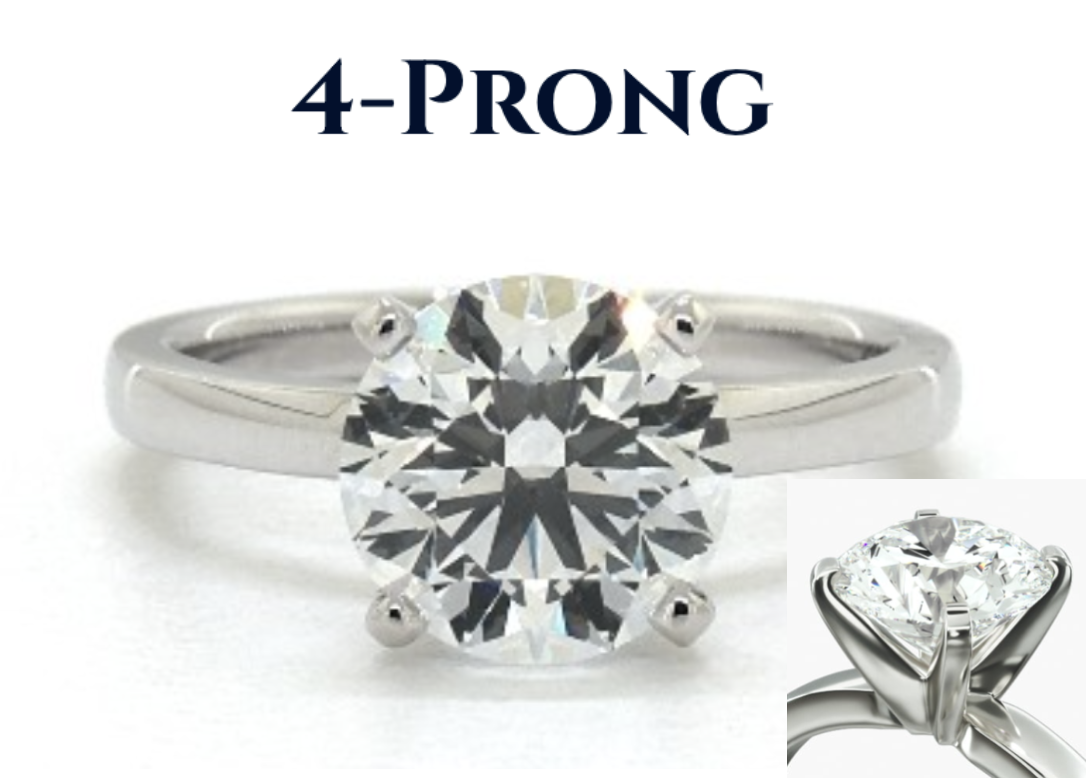
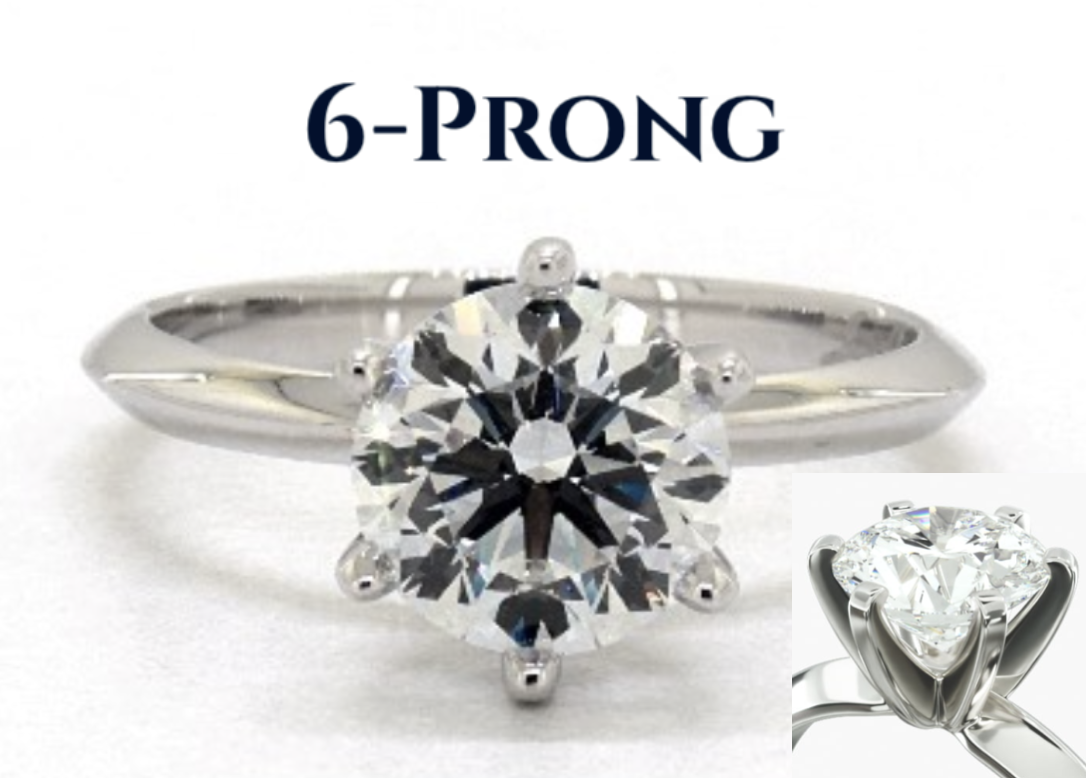
Six prongs provide a little extra protection and can give round diamonds a more rounded or floral appearance. This is also the foundation of the classic Tiffany-style approach, which uses six-prongs. You can see that in the diamond above on the right the six prongs form a subtle petal-like frame around the stone, softening the edges and giving it a more delicate, flower-like look. This choice exists in other setting types too, but in a solitaire it has a much stronger visual impact since the diamond is the only focal point.
In solitaire settings the thickness of the band also plays a bigger role than most people realize. Since there are no side stones or halo elements competing for attention, the band becomes a major part of the overall look and it can dramatically affect how big or small the center diamond appears.
Take the two rings below: both feature a 1.01 carat diamond, but the effect is completely different. The ring on the left has a thicker 3.3 mm band, which gives a bold, solid feel and makes the diamond look a bit more integrated into the design. The one on the right has a thin 1.5 mm band and as a result, the diamond appears larger and more prominent, almost floating on the finger:
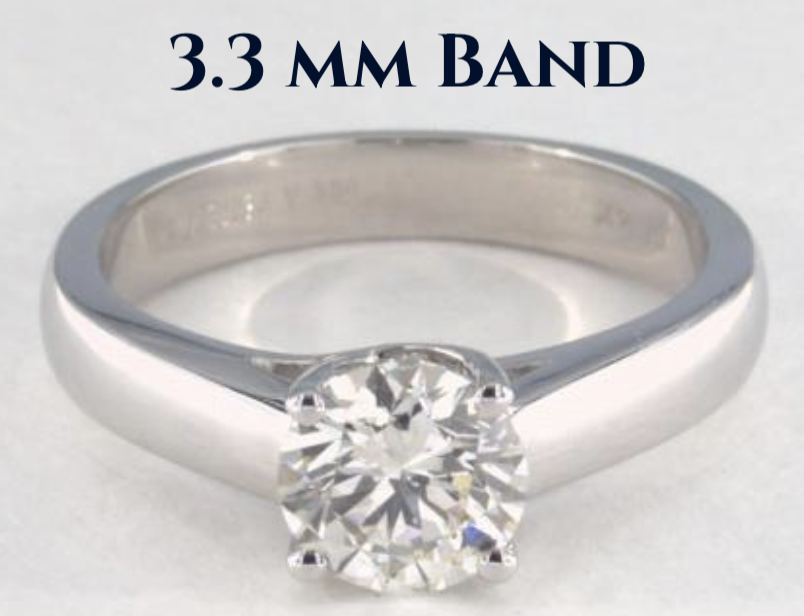
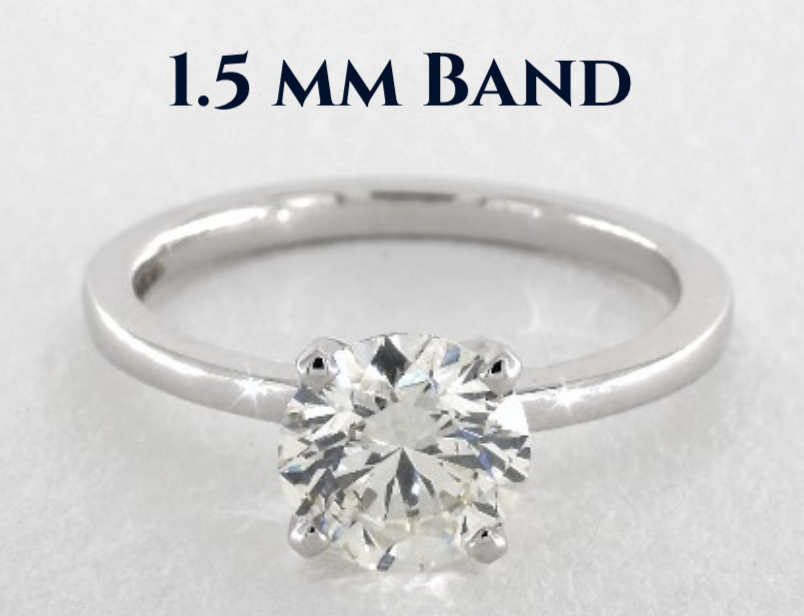
Thinner bands also tend to look more delicate and modern, while thicker bands feel sturdier and more traditional. There’s no right or wrong, it depends on personal style and how much visual contrast you want between the diamond and the band.
For protection, solitaire rings are considered medium. The diamond is more exposed than it would be in a bezel setting, but it offers similar protection to most prong-based designs, including channel or pavé styles. As for maintenance, solitaires are some of the easiest rings to clean. With fewer small stones and no complex design details, you can keep them looking great with very little effort.
If you’re after a ring that feels classic, elegant and easy to wear every day, the solitaire setting is a great choice.
You can explore more examples and helpful tips in my full guide to the solitaire engagement ring setting.
Halo Setting
The halo setting is the second most popular engagement ring style, making up around 15 to 18 percent of all rings. Its popularity has grown steadily over the last decade and it’s easy to see why. A halo surrounds the center diamond with a ring of smaller stones, which adds a ton of sparkle and makes the main stone look bigger than it actually is.
That’s why many buyers use halo settings as a strategic way to save on carat weight. A well-designed halo can add up to 1.5-2 mm to the perceived diameter of the ring, making a 0.70 or 0.80 carat diamond look closer to 1 full carat when viewed from above.
In the two rings below, the center diamond in the halo setting (left) weighs just 0.75 carats, while the pavé ring on the right holds a larger 1.01 carat diamond. Yet despite the weight difference, the halo ring actually gives the illusion of a larger center stone. That’s because the surrounding halo adds visible surface area, extending the diameter of the ring face and drawing the eye outward.
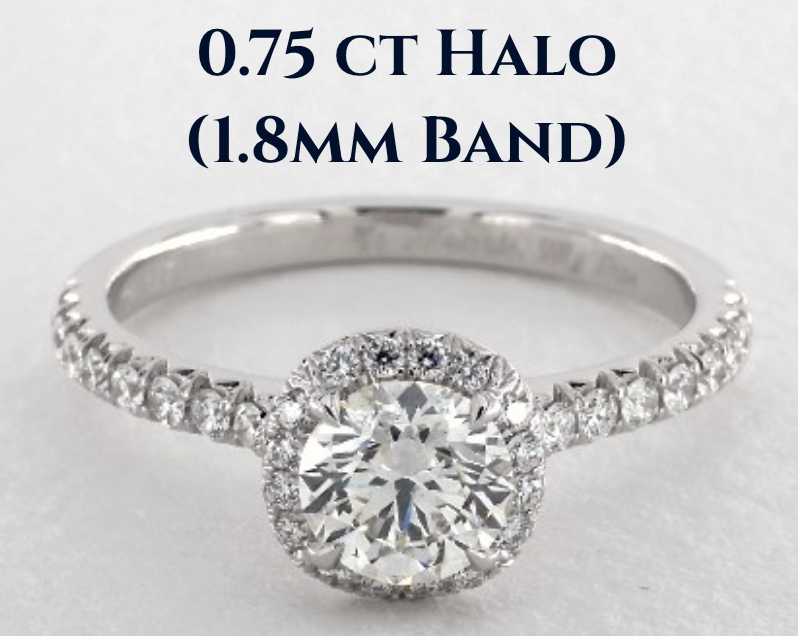
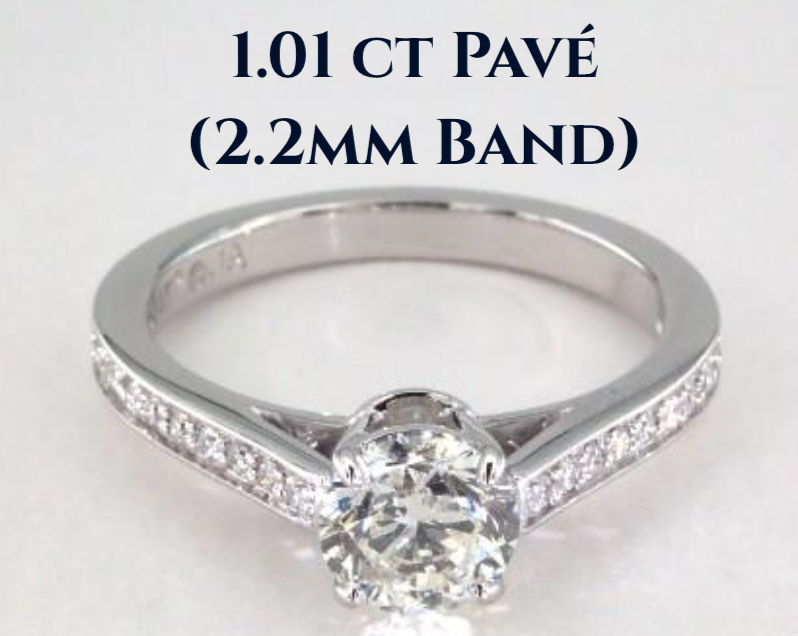
On top of that, the thinner 1.8 mm band on the halo ring creates additional contrast, making the center diamond appear even bigger by comparison. Meanwhile, the 2.2 mm band on the pavé setting is slightly wider, which tends to make the diamond look more proportionate, but not quite as enlarged.
This example highlights how a thoughtfully designed halo setting can let you choose a smaller (and more affordable) diamond while still achieving the visual presence of a full-carat stone. It’s one of the most popular strategies for maximizing value without compromising on look.
Most halo settings also use pavé-style diamonds around the halo itself and sometimes along the band. So while pavé is technically a separate setting type, many people who choose a halo are also choosing a pavé ring by default, which helps explain why halos tend to rank higher in popularity overall.
These two rings below show the difference between a pure halo setting (left) and a combined halo with pavé setting (right). Both rings feature a 0.90 carat center diamond, but the visual impact is quite different. The ring on the left features only the halo of small diamonds around the center stone, without any additional accents on the band. In contrast, the ring on the right adds a row of pavé diamonds along the shank, enhancing the sparkle from every angle.
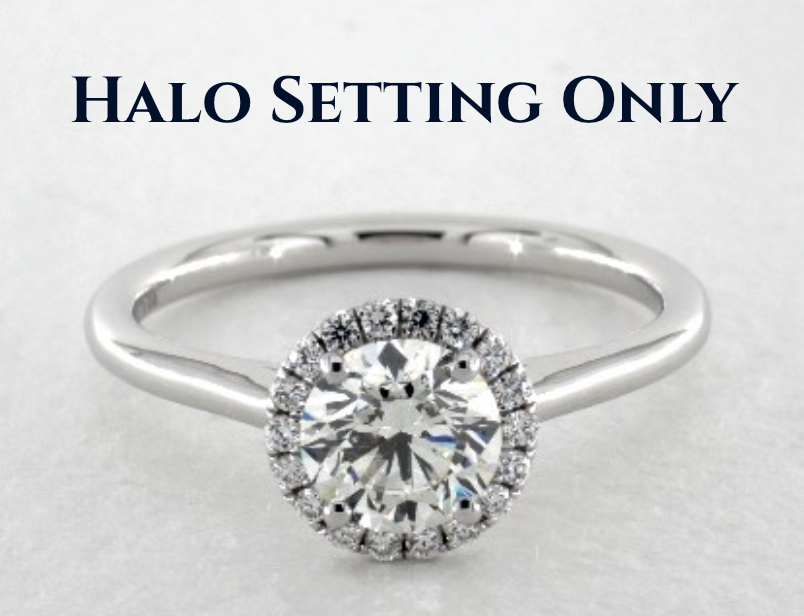
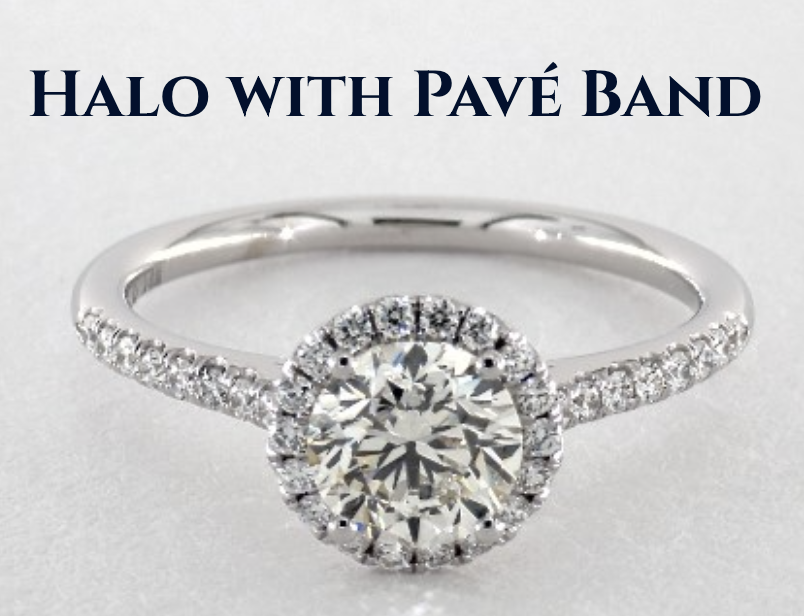
While both are technically halo settings, the version with added pavé is far more common in practice. In fact, it’s relatively rare to see a halo ring without pavé accents on the band. The reason is simple: most people who choose a halo setting are looking for maximum sparkle and pavé accents deliver just that. The extra stones draw the eye down the band and make the whole ring feel more radiant and luxurious.
This setting is ideal if you want maximum shine without having to upgrade to a larger center diamond. Because of the added surface area and light reflection the halo setting ranks high in overall sparkle. You get light bouncing off the center stone and the entire halo which creates that eye-catching flash a lot of people love.
In terms of protection halo settings sit around the middle. The small diamonds in the halo offer a bit of extra structure around the center stone, but they don’t cover it fully like a bezel would. As for maintenance halo rings require more cleaning than a solitaire. The tiny stones can collect dirt and oils, and they’re more prone to buildup, but regular cleanings keep them looking sharp.
If you’re drawn to rings that catch the light from across the room or you want the illusion of a larger diamond without going up in size, the halo setting is a smart and stylish choice.
You can explore examples and expert tips in my complete guide to the halo engagement ring setting.
Pavé Setting
The pavé setting is the third most popular engagement ring style, making up roughly 12 to 15 percent of all rings. The word pavé comes from the French word for “paved,” and that’s exactly what this style looks like: a band paved with small diamonds that sit flush with the metal, giving the appearance of a continuous sparkle.
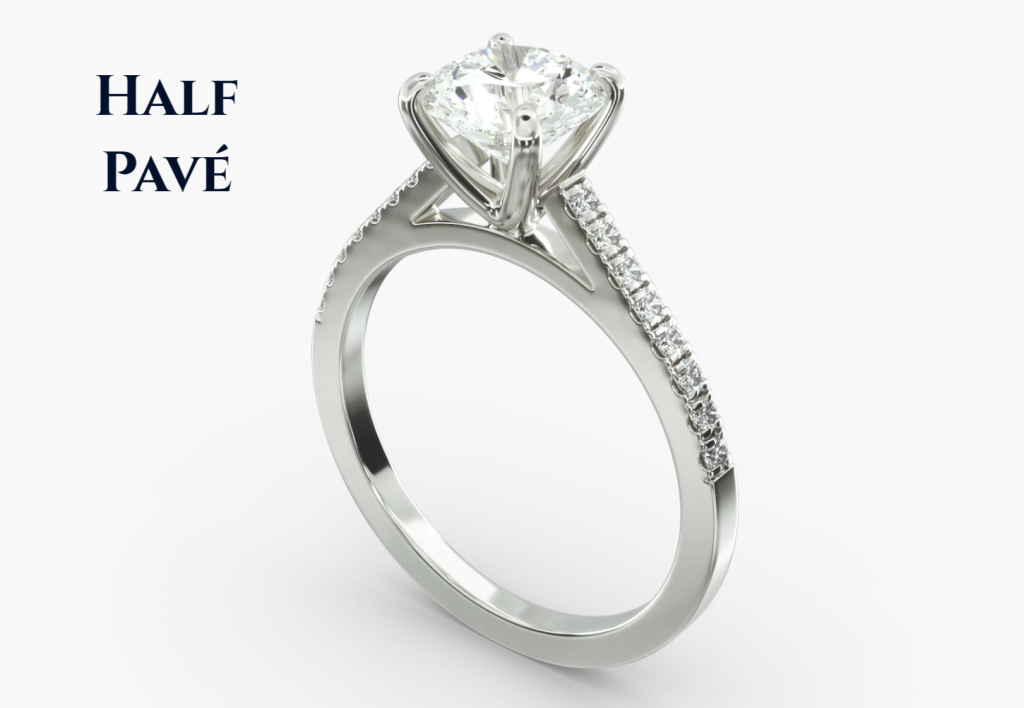
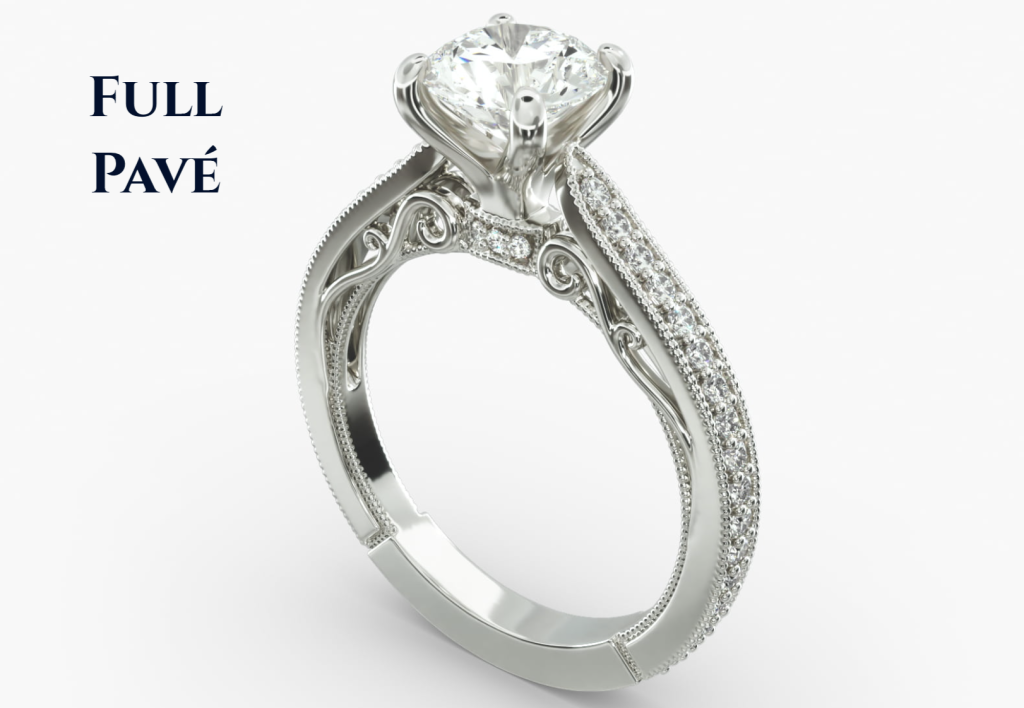
Pavé settings are all about enhancing the look of the band without taking attention away from the center stone. These tiny diamonds are usually set into the shank, either halfway down the band or all the way around in what’s called a full pavé. Because of the added shimmer from the band this setting scores high for overall sparkle. It creates a glittering frame around the center stone, especially when viewed from the side.
Full pavé settings are notoriously difficult to resize, since the diamonds often extend around the entire band, leaving no safe area for adjustment without risking damage or loosening. So if you’re not sure of the final ring size, half pavé is a safer bet.
Despite how delicate they look, pavé stones aren’t glued. Jewelers drill tiny holes into the band, place the diamonds and then raise small beads of metal to hold each one in place. These are sometimes called bead-set or micro-prong pavé.
Within pavé styles, there are elegant variations: French pavé features V-shaped cuts between each stone for a crisp, refined look, often showing more individual framing around each diamond. U-cut pavé, on the other hand, uses rounded grooves beneath the stones, creating a smoother, more seamless appearance from above with extra sparkle from the sides:
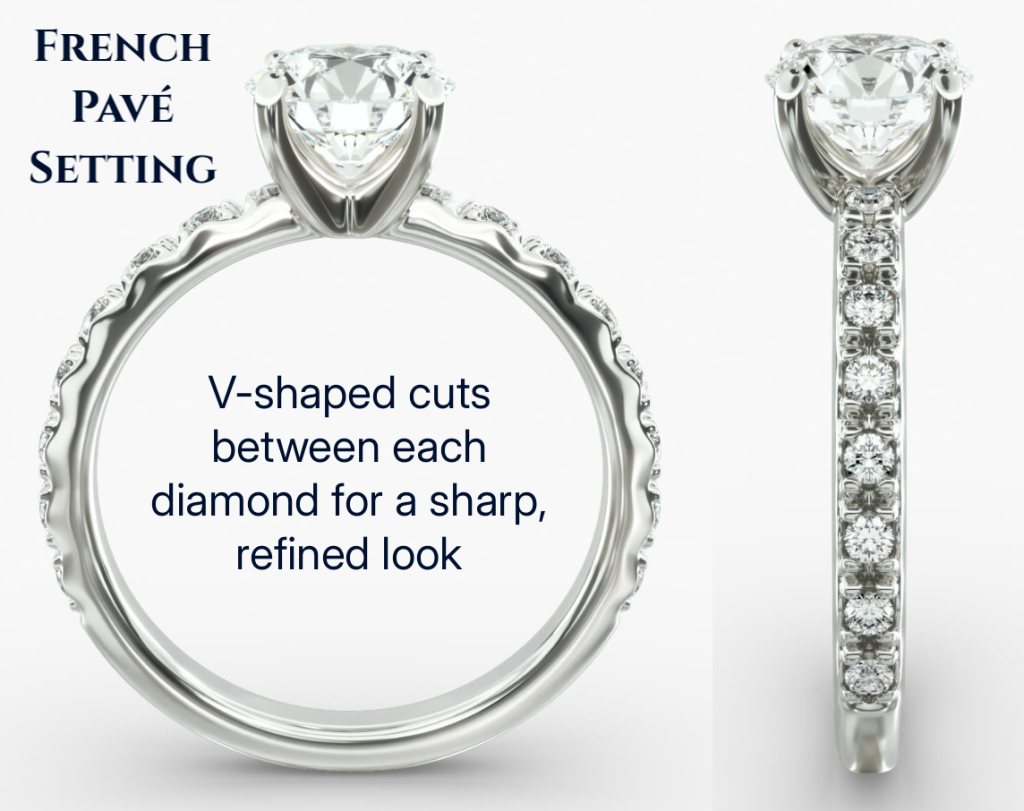
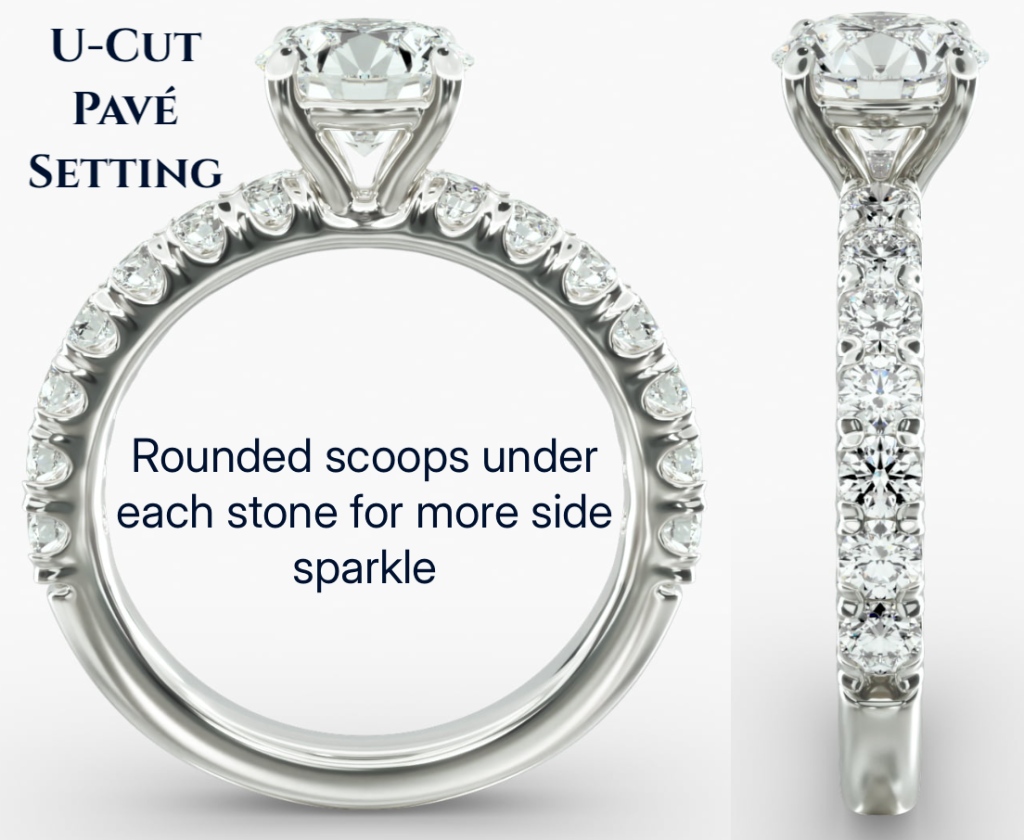
In terms of protection, pavé settings are about average. The center diamond is usually held by prongs just like in a solitaire, but the small pavé stones along the band can be more delicate. They’re not difficult to maintain, but they do require a little more care. Pavé rings should be cleaned regularly and it’s a good idea to check that the small stones are still secure from time to time.
If you like a little extra detail and sparkle without going all in on a halo or side-stone setting, pavé offers a balanced, elegant look that still feels refined.
You can learn more about variations, pros and cons and real-world styling in my full guide to the pavé engagement ring setting.
Three-Stone Setting
The three-stone setting makes up around 7 to 10 percent of engagement rings and has held steady as a popular choice for couples who want more than just sparkle, they want meaning. Each of the three stones traditionally represents the past, present and future of your relationship, which gives the ring an emotional layer that many people connect with.
Visually this setting offers a lot. You have a larger center diamond, often flanked by two slightly smaller side stones. This setup adds balance and visual weight without overpowering the main stone. The sparkle level is high, especially when the side stones are well-matched and proportioned. Light reflects not just from the center, but from all three angles, creating a wide flash effect that catches attention from across the room.
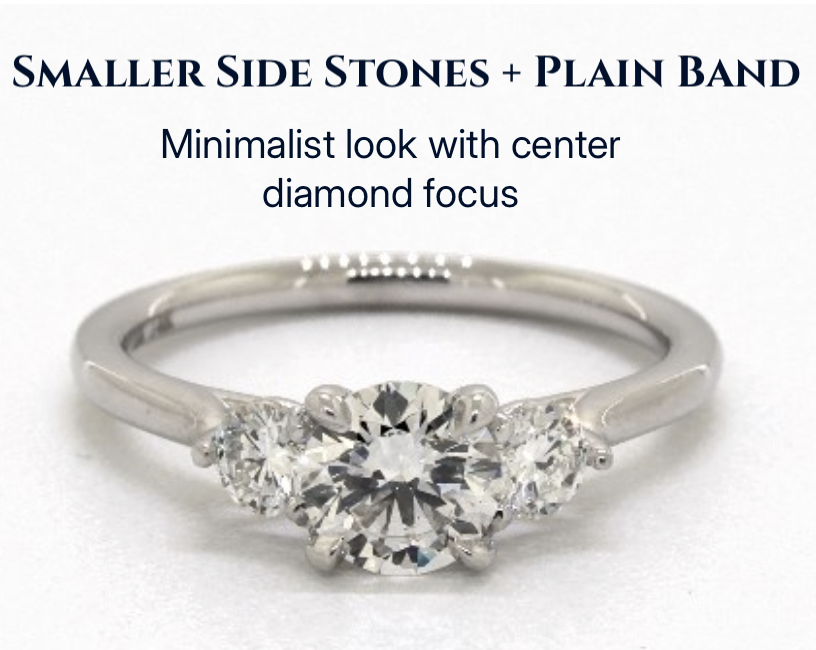
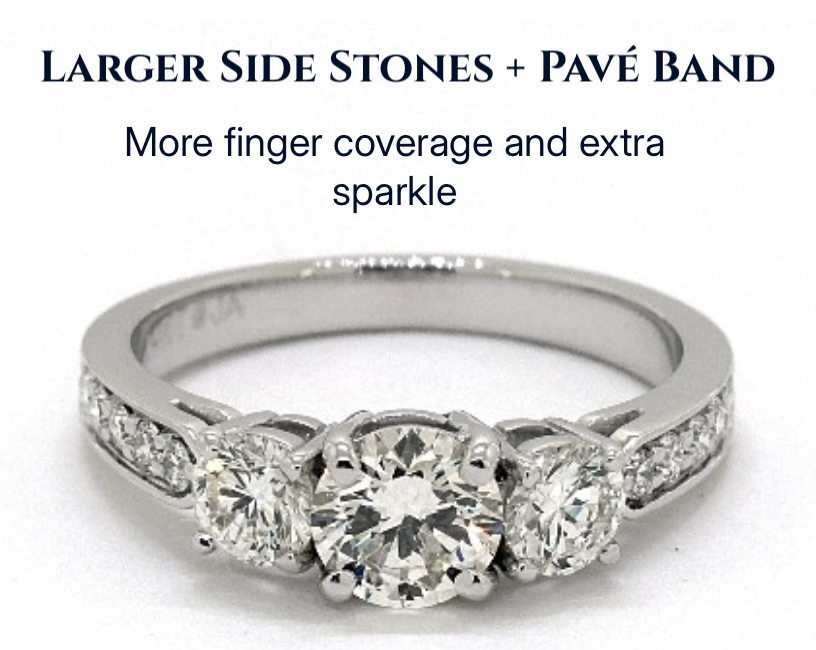
The ring on the left features smaller side stones and a clean, unadorned band. It’s an elegant, minimalist take on the three-stone design and is ideal for someone who prefers a subtle, balanced look where the center diamond remains the clear focal point. This style pairs beautifully with slim fingers or understated fashion preferences.
In contrast, the ring on the right uses larger side stones and a pavé-set band to create a more glamorous effect. It offers greater finger coverage, more overall sparkle and a sense of symmetry that can flatter wider fingers or anyone looking for a bolder, more dazzling presence. This option is perfect for buyers who love extra brilliance and visual richness without moving into halo territory.
In terms of protection three-stone settings are considered medium. Like a solitaire the center diamond is usually held in prongs, but the side stones offer a bit of extra support and stability. As for maintenance they’re fairly manageable. There are more stones to clean than in a solitaire or halo, but far fewer than in pavé or vintage styles.
If you’re drawn to rings with symbolism and a little extra visual depth, a three-stone setting blends meaning, sparkle and balance in a way that feels both classic and personal.
You can explore different stone pairings and visual effects in my full guide to the three-stone engagement ring setting.
Bezel Setting
The bezel setting makes up about 5 to 7 percent of engagement rings and is especially popular with people who want a sleek, modern look or something built for everyday wear. Unlike prong settings, which hold the diamond with small claws, a bezel surrounds the entire edge of the diamond with a thin band of metal. This gives the stone a smooth, clean outline and a very secure hold.
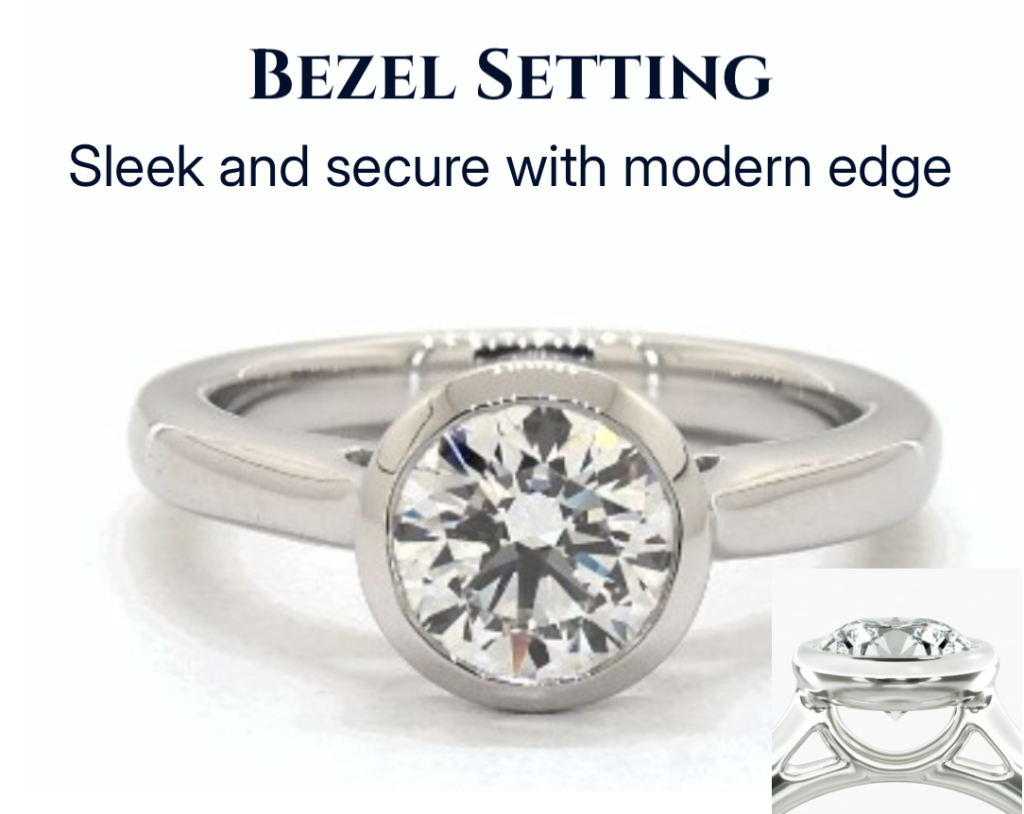
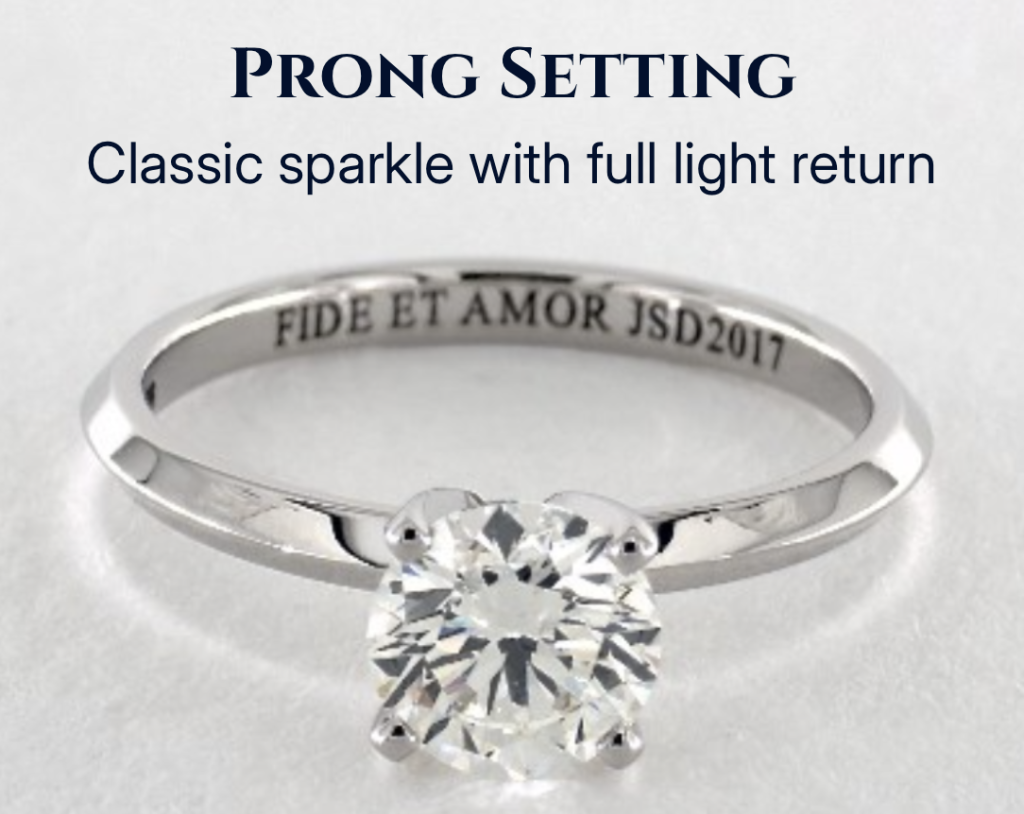
Both rings shown above feature a 1.2 carat round center diamond and a 2.00 mm band, but the settings create two very different impressions.
Because it surrounds the entire edge of the stone, the bezel setting reduces brilliance by about 8 to 15 percent on average compared to an open prong setting. This is mainly due to reduced light entry from the sides. That said, a well-cut diamond still performs beautifully and as you can see in the video below, light continues to enter through the top and underside of the ring.
For many, the tradeoff is well worth it: you get a clean, modern look with unmatched protection for everyday wear.
And protection is where bezel settings shine. This is the most secure option you can choose. The metal frame shields the edges of the diamond from bumps and daily wear, making it a favorite for anyone with an active lifestyle or hands-on job. It’s also one of the easiest settings to maintain. There are no tiny side stones to clean or prongs to check and the smooth design resists snagging on clothes or hair.
If you’re looking for a setting that’s low-fuss, modern and built to last, the bezel is a solid pick.
You can see examples, metal variations, and styling tips in my full guide to the bezel engagement ring setting.
Channel Setting
The channel setting makes up about 4 to 6 percent of engagement rings and is especially popular for people who want a smooth, structured look with added sparkle along the band. In this style, small diamonds are set into a groove between two parallel strips of metal, forming a “channel” that holds the stones securely in place. This design is often used for accent diamonds along the shank, paired with a prong-set center stone.
While many people confuse the channel setting with pavé, the side-by-side view below reveals key differences in both structure and sparkle. Both rings feature a 0.75 carat center diamond and a 2.2 mm band, but the way the side stones are held in place changes the entire look and feel:
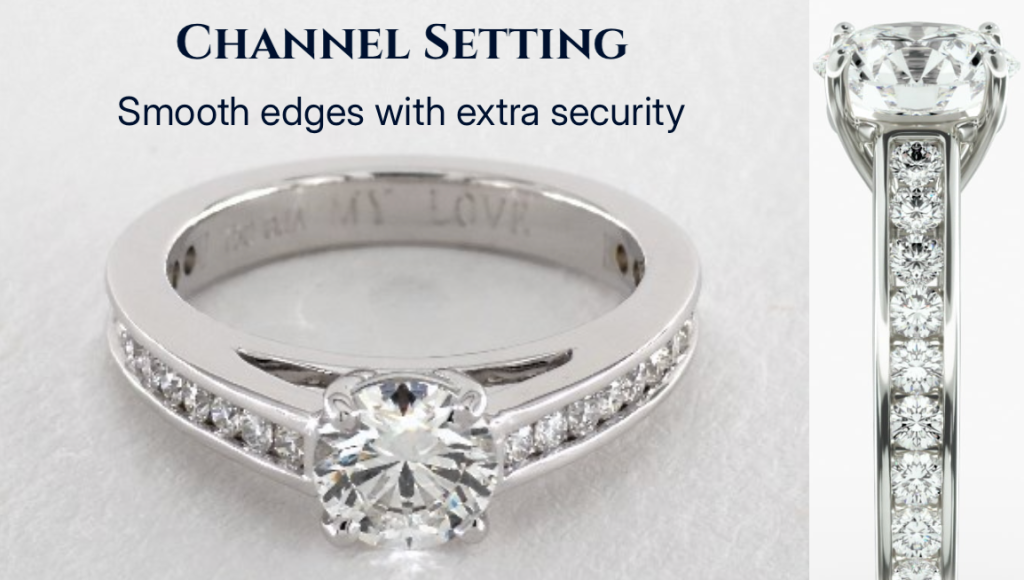
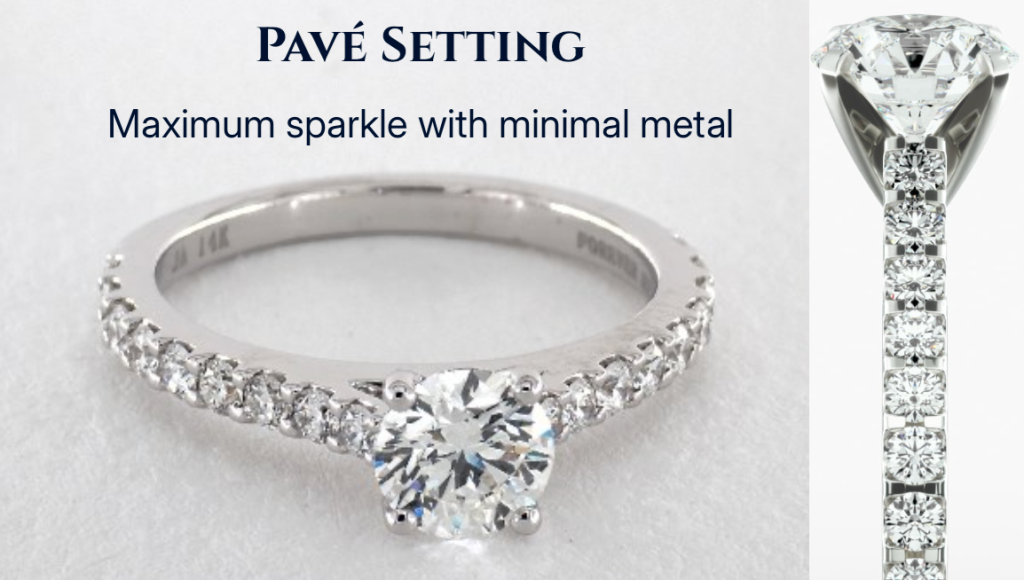
In the channel setting each diamond sits snugly between two strips of metal with minimal spacing between stones. This gives the illusion of a continuous line of diamonds, but the channel walls slightly reduce light entry from the sides. In contrast, the pavé ring exposes more of each diamond, using tiny prongs or beads between the stones. While this introduces a touch more visible metal between each diamond, that contrast actually enhances sparkle, especially when viewed in motion.
Ultimately, pavé settings offer more shimmer but are slightly more delicate. Channel settings provide a smoother feel, better durability for active lifestyles and a more structured, classic appearance. If you want a secure setting that still gives you a sparkle-rich band with clean edges, the channel setting is an excellent choice. All in all, channel settings land right in the middle in terms of sparkle.
As you can see, channel settings score high when it comes to diamond protection. The metal borders shield the sides of the small diamonds, making them less likely to chip or fall out. This style also avoids prongs along the band, which means fewer points that can bend or snag. Maintenance is fairly easy, but like any setting with multiple small stones regular cleaning helps keep it looking crisp.
If you like symmetry, clean lines and a durable design with understated brilliance, the channel setting is a solid choice.
You can explore different variations and styling ideas in my full guide to the channel engagement ring setting.
Hidden-Halo Setting
The hidden halo setting has grown steadily in popularity over the last few years and now makes up about 3 to 5 percent of engagement rings. Unlike the classic halo the hidden halo adds a subtle ring of diamonds beneath the center stone rather than around it. From the top it looks like a solitaire, but when you tilt the ring, you see a burst of sparkle tucked under the diamond.
What makes the hidden halo unique is that it’s more of a design feature than a full setting style on its own. It’s most often paired with solitaire-style rings like the ring above, cathedral settings and sometimes even three-stone designs. It adds a modern twist to these styles without changing their overall shape or layout.
In terms of sparkle the hidden halo ranks high. It won’t be as flashy as a full halo from above, but it catches light from different angles and adds a bright pop when viewed from the side. The diamonds are usually pavé-set around the gallery or basket that supports the center stone.
Protection is about average. The center stone is still held in place with prongs, just like a solitaire and the hidden halo adds a bit of extra structure. As for maintenance, it’s a little more involved than a plain solitaire. The side-facing diamonds can trap oils and dust, so regular cleaning helps keep that surprise sparkle looking crisp.
If you want something clean and classic with a little hidden detail that sets it apart, the hidden halo is a beautiful way to add personality without changing the face of the ring.
You can see more design variations and styling ideas in my full guide to the hidden halo engagement ring setting.
Side-Stone Setting
The side-stone setting makes up around 3 to 5 percent of engagement rings and is one of the more flexible styles in terms of design. The name itself is more of a category than a specific ring type. It simply means the center diamond is flanked by smaller stones along the band, but how those stones are arranged can vary a lot.
Both rings below feature a round center diamond of approximately 0.7 carats, their visual impact is quite different, though. The ring on the left uses tapered side stones that gradually decrease in size, creating a soft, narrowing effect that naturally draws the eye toward the center. This helps the main diamond appear larger and more prominent
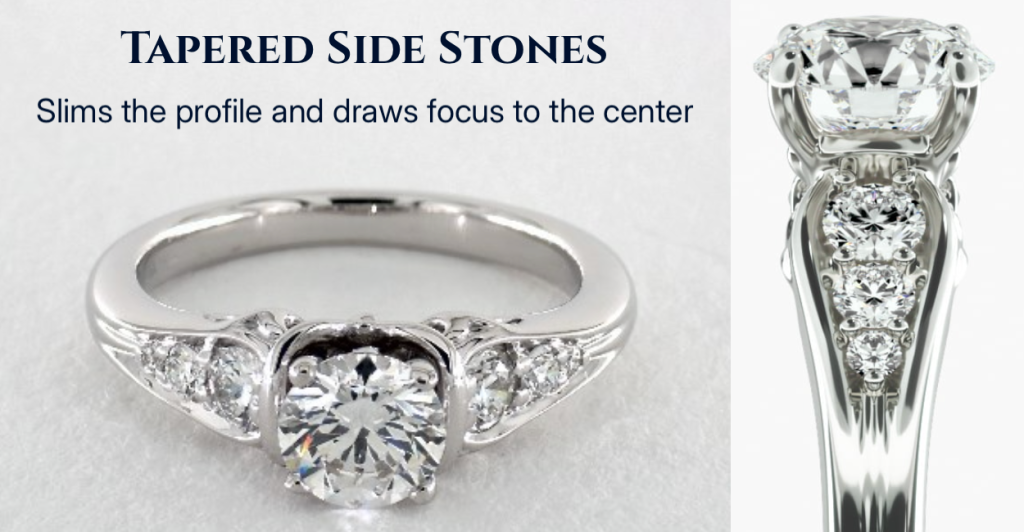
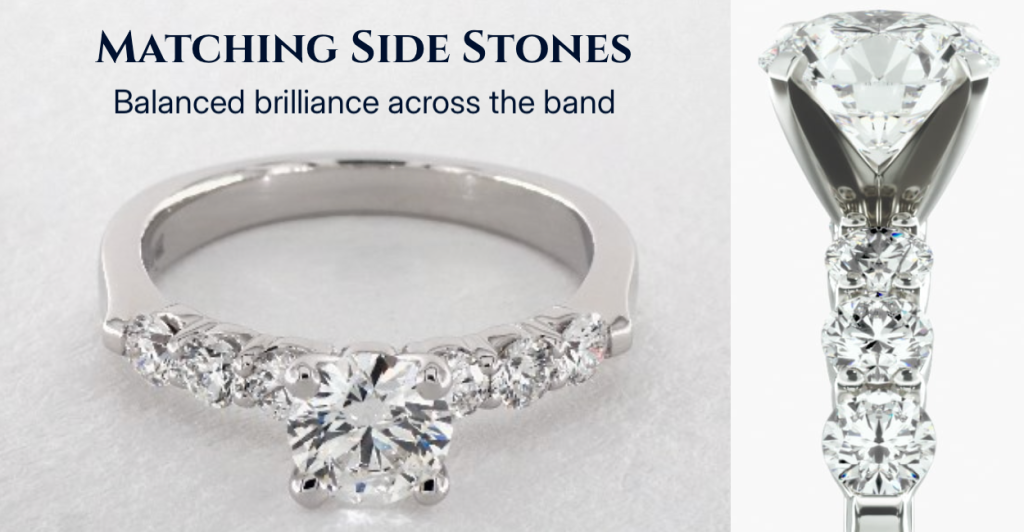
The ring on the right features uniform side stones that are all the same size. This design creates a more symmetrical and sparkling presence across the entire band. At a glance, some people might mistake this for a pavé setting, but it’s not. Pavé settings use tiny melee diamonds set close together in a glittering surface, while this ring features larger, individually prong-set diamonds. It’s a true side-stone setting, offering a bold, structured look with extra finger coverage.
Side-stone rings often feature diamonds or other gemstones set into the shank in ways that complement the center stone. The most common layout includes small round or tapered diamonds set into the shoulders of the band. These side stones are typically set using shared-prong, channel or bezel settings, depending on the style of the ring. In some cases colored gemstones are used to create contrast or personal meaning.
Technically, the three-stone setting is a specific type of side-stone ring, just one with larger and more defined side diamonds. So while the three-stone design is its own popular category, it’s still rooted in this broader style.
In terms of sparkle side-stone settings fall in the middle. They add noticeable shimmer from the band without overpowering the center diamond. The overall look is more layered and complete than a plain solitaire but still more understated than a halo or pavé-heavy design.
Diamond protection depends on how the side stones are held. Channel and bezel styles offer more security, while shared-prong designs may need a bit more care. Maintenance varies based on the number of stones and how they’re set, but regular cleanings will keep the sparkle strong.
If you want a ring that offers extra elegance and subtle shine along the band without changing the silhouette too much, a side-stone setting is a beautiful and versatile option.
You can explore stone combinations and variations in my complete guide to the side-stone engagement ring setting.
Cathedral Setting
The cathedral setting accounts for about 2 to 4 percent of engagement rings and is best understood as a structural design feature rather than a standalone setting style. It’s defined by its signature metal arches that rise up from the shank to meet the center stone, much like the graceful curves of a cathedral ceiling, which is where the name comes from.
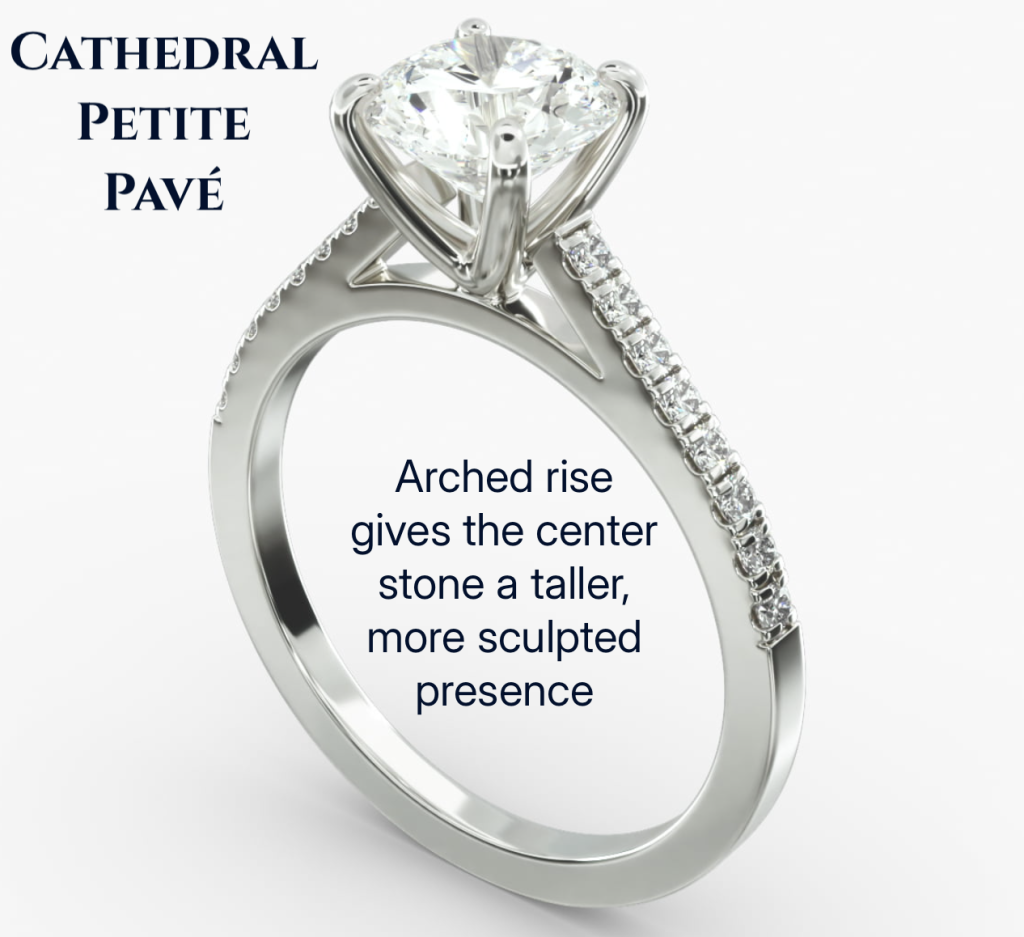
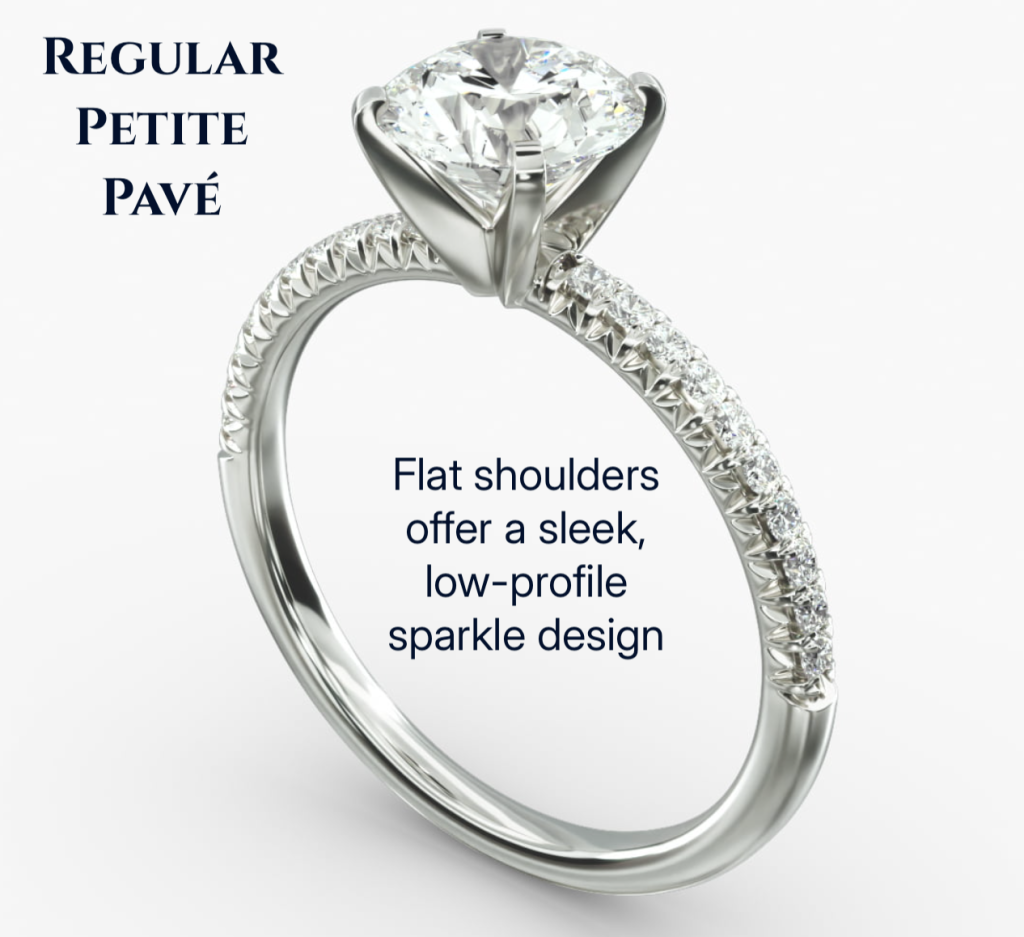
What makes this design special is how it lifts the diamond up, creating a taller, more dramatic profile. This can make the center stone appear larger and more prominent, especially from the side view. But unlike a halo or side-stone ring that adds extra sparkle the cathedral setting focuses on enhancing the silhouette.
Cathedral arches can be combined with a variety of actual setting types. The most common pairings are:
- Solitaire cathedral rings, which give a simple setting more dimension and elegance.
- Halo cathedral rings, which elevate the entire head of the ring for added presence.
- Three-stone cathedral rings, where the arches flow naturally into the side stones for a balanced look.
- Pavé cathedral rings (like the images above), which combine the lifted profile with delicate sparkle along the band for added elegance and brilliance without overwhelming the center stone.
The sparkle level in cathedral settings is moderate. It depends on whether the ring includes additional diamonds like a halo or pavé band. On its own a cathedral doesn’t add sparkle, it’s the height and shape that create impact.
Protection is average. The elevated position does expose the diamond a bit more than lower-profile settings, but it’s still very secure if the prongs are well made. Maintenance is straightforward unless small diamonds are added along the arches, in which case more detailed cleaning might be needed.
If you’re drawn to rings that feel architectural and elegant or you just want a setting that gives your diamond a little lift without adding side stones, the cathedral design is a graceful and timeless choice.
You can explore visual examples and variations in my full guide to the cathedral engagement ring setting.
Vintage-Inspired Settings
Vintage-inspired settings make up about 2 to 4 percent of engagement rings and they’re perfect for anyone who loves detail, charm and a strong sense of history. These rings aren’t defined by a single structure or stone layout, instead they borrow elements from antique styles that were popular in different eras.
This setting category is broad and can include rings with milgrain detailing, filigree work, engraved bands, floral motifs or geometric patterns inspired by periods like Edwardian, Victorian or Art Deco. Some vintage designs also feature colored gemstones or old-world diamond cuts like the rose cut or cushion cut to give them an even more authentic feel.
It’s also common to see vintage settings paired with lower color grade diamonds, especially in the J to M range. In fact, this is often done intentionally. Warmer diamonds tend to look more at home in antique-style settings, where the yellow or rose gold tones blend beautifully with a softer, romantic glow. Rather than fighting the color, vintage designs often embrace it as part of the overall aesthetic.
Because of the variety of small diamonds and detailed metalwork, vintage-inspired settings tend to rank high in overall sparkle, not always from a flashy center stone, but from the intricate accents and textures that catch light from all angles.
When it comes to protection, vintage rings sit around the middle. Some offer more coverage with bezel or hybrid prong styles, but the added detail work can make them slightly more delicate. Maintenance is a little more involved than with a plain setting. All the small crevices and decorative touches can collect dust or oils, so regular cleaning is key to keeping the ring looking sharp.
If you’re drawn to designs that tell a story and feel one-of-a-kind, a vintage-inspired setting offers timeless character with just the right mix of romance and craftsmanship.
You can explore the most popular design eras and specific vintage elements in my full guide to vintage-inspired engagement ring settings.
Tension Settings
Tension settings are one of the most visually striking and modern engagement ring styles, but they’re also the rarest, making up less than 1 percent of rings. This setting type first appeared in the late 1960s and gained traction in the 1980s, when advancements in precision engineering and metallurgy made it possible to safely suspend a diamond using pressure alone.
Unlike traditional settings that use prongs, bezels or channels, a tension setting holds the diamond in place through compression. The ring is designed with exact tolerances, allowing the metal to grip the diamond securely between two open ends, giving it the illusion that the stone is floating in mid-air.
Because of this structure, tension settings offer medium sparkle, they let in a lot of light from the sides, but there are no side stones or halos to boost brilliance. The result is a clean, futuristic look that puts the diamond on full display from nearly every angle.
They’re also typically more expensive than other settings. That’s because tension rings aren’t just jewelry, they’re engineering. Each ring has to be custom-calibrated to match the exact dimensions of the diamond and metal type and it takes more time and expertise to get it right. They’re often made from high-strength metals like titanium or platinum to maintain the necessary pressure.
In terms of protection, tension settings rank lower. While the diamond is held tightly, it’s also more exposed to direct impact. They’re made from strong metals like titanium or platinum to compensate for this, but they’re still better suited for careful wearers. Maintenance is about average, but tension rings should be resized or repaired only by specialists, since even small changes can affect the pressure holding the stone.
If you’re drawn to bold, minimalist design and love the idea of a ring that feels more like a piece of sculpture than traditional jewelry, the tension setting is unlike anything else.
You can learn more about design variations, metal types, and diamond requirements in my complete guide to the tension engagement ring setting.
How to Choose the Right Setting for Your Lifestyle
Not every engagement ring setting is a perfect match for every lifestyle. Some styles are built for elegance and sparkle, while others are better suited for daily wear, hands-on work or anyone who wants something low-maintenance.
If you’re active, always on the go or prefer simplicity, certain settings will hold up better over time. On the flip side, if your priority is maximum shine or making certain diamond features less noticeable, the setting can help you get the most out of your stone. Here’s a quick breakdown to help match your setting choice to your lifestyle and priorities:
| Lifestyle or Goal | Recommended Setting Types | Why It Works |
|---|---|---|
| Active lifestyle | Bezel, Channel, Low-Profile Solitaire | These settings offer strong diamond protection, sit lower on the finger and are less likely to snag or get damaged with movement. |
| Minimal maintenance | Solitaire, Bezel, Tension | Fewer small stones, fewer crevices and simple construction make these settings easier to clean and maintain long term. |
| Maximum sparkle | Halo, Pavé, Three-Stone | These designs maximize surface brilliance through accent stones and layered light reflection, adding lots of visual impact. |
| Hiding inclusions or color | Halo, Vintage-Inspired, Pavé | Decorative details and accent stones draw the eye outward, helping to soften or hide minor flaws in the center diamond. |
Keep in mind that no setting is perfect in every situation, but knowing what to expect can help you narrow things down quickly. If you already have a sense of your priorities like durability, sparkle or ease of upkeep, your best-fit setting style will usually reveal itself. From there, it’s just a matter of matching the right design to your diamond and personal taste.
Matching the Setting to Your Diamond Shape
When you’re choosing a setting, the shape of your diamond plays a big role in what will look and feel right. Not every setting style flatters every shape in the same way. Some shapes, like round or oval, are versatile and work with almost anything. Others, like marquise or pear, need more protection around the tips or they just look more balanced in certain layouts.
For example, a halo setting can add width and visual weight to a narrow shape like a marquise or pear, making it feel more centered on the hand. On the other hand, a cushion-cut diamond often pairs beautifully with vintage-inspired settings that echo its soft curves and old-world charm.
Below is a quick guide that shows which diamond shapes tend to work best with which setting styles, and why those pairings usually make sense.
| Diamond Shape | Works Best With | Why It Works |
|---|---|---|
| Round | Solitaire, Halo, Pavé, Cathedral | Versatile and most brilliant shape. Pairs well with nearly every setting type, from minimalist to ornate. |
| Oval | Halo, Solitaire, Hidden Halo | Elongated shape enhances finger length. Looks larger per carat. Hidden halos often work well with its curves. |
| Cushion | Halo, Vintage-Inspired, Cathedral | Rounded corners soften the look. Often used in vintage and romantic designs. Halos enhance their shape. |
| Princess | Channel, Halo, Three-Stone | Square shape pairs well with clean-lined settings. Channel bands emphasize its symmetry. |
| Emerald | Bezel, Three-Stone, Vintage-Inspired | Step-cut facets benefit from simple or classic settings. Pairs well with baguette side stones. |
| Radiant | Halo, Pavé, Cathedral | Similar to emerald but with more brilliance. Works well in sparkling, high-profile settings. |
| Marquise | Halo, Solitaire, Vintage-Inspired | Elongated shape with pointed ends. Often paired with halos or ornate galleries for balance. |
| Pear | Halo, Bezel, Cathedral | Tapered shape is often offset with protective settings. Halos and bezels guard the pointed tip. |
| Asscher | Halo, Vintage-Inspired, Three-Stone | Step-cut and square shape suits geometric or antique-inspired settings. |
| Heart | Halo, Bezel, Solitaire | Symbolic shape benefits from settings that protect the cleft and tip. Halos enhance outline visibility. |
Keep in mind that there are no hard rules, these are just tried-and-true combinations that bring out the best in each diamond shape. If you already have a shape in mind, this table can help you narrow down setting options that will highlight its strengths and give you the look you’re after.
And if you’re still exploring, this is a great way to spot patterns and get a better feel for what makes certain pairings feel timeless, balanced or bold.
Setting Metals and Their Impact on Appearance
Most people already have a natural preference for one metal over another, often without even thinking about it. Whether it’s based on your skin tone or just the kind of jewelry you’ve always worn, there’s usually one that just feels right. If you’re not sure, try comparing different metals against your hand in natural light, the one that feels most “you” is probably the best match.
The metal you choose for your ring setting isn’t just a background detail, it plays a big role in how the entire ring looks and feels. Metal color affects how your diamond appears, how visible the setting is on your hand and how the ring reflects light overall. It can even influence how warm or cool your diamond looks, especially in borderline color grades.
Here’s a quick breakdown of the most common options:
- White gold has a bright, silvery tone that blends in with the diamond. It’s a great choice if you want the focus to stay fully on the stone. It works especially well with near-colorless diamonds and cooler-toned skin.
- Yellow gold brings out warmth in the ring and gives it a more traditional or vintage feel. Because the metal reflects a golden tone into the diamond, even colorless stones can take on a slightly warmer look. That’s why yellow gold works especially well with lower color grades like J or K, the warmth of the metal makes any natural tint feel more intentional and cohesive. Most settings come in either 14K or 18K yellow gold and the one you choose affects how rich the color looks and how durable the ring is.
- Rose gold has a soft, blush tone that adds romance and uniqueness. It flatters most skin tones and pairs beautifully with vintage-inspired settings. It can also soften the contrast around the diamond.
- Platinum is naturally white and very durable. It won’t fade like white gold over time, but it does develop a patina with wear. It’s heavier and more premium and often chosen for its strength and hypoallergenic qualities.
Each metal has its own tone, weight and long-term behavior, so your choice here isn’t just aesthetic, it’s practical too.
| Metal | Visual Tone | Best Diamond Color Pairing | Durability | Maintenance | Popular Use Cases |
|---|---|---|---|---|---|
| White Gold | Bright silver | D to H | Medium | Requires rhodium replating over time | Classic solitaires, halos |
| Yellow Gold | Warm yellow | I to M | Medium | Low maintenance, easy to polish | Vintage styles, traditional looks |
| Rose Gold | Blush pink | H to K | Higher (due to copper alloy) | Low upkeep, resists tarnish | Romantic, vintage-inspired settings |
| Platinum | Bright white | D to J | Very high | Develops patina, no replating needed | Premium rings, high-durability designs |
People with lighter skin tones often find that white metals like platinum and white gold blend in naturally and highlight the diamond’s sparkle. Those with deeper or darker skin tones usually get great contrast from yellow or rose gold, which brings warmth and richness to the overall look.
If you want a deeper dive into durability, pricing, maintenance and how each metal pairs with different settings, check out my full guide to ring metals.
Common Mistakes to Avoid When Choosing a Setting
Choosing the right setting isn’t just about style, it’s about making sure the ring fits your lifestyle, highlights your diamond and holds up over time. Here are some of the most common mistakes people make when choosing a setting, and how to avoid them:
- Prioritizing trend over function
Some designs look stunning in photos but are hard to wear daily. Always consider how the ring will feel on your hand and how much care it will need. - Picking a high-set ring for a hands-on lifestyle
A tall setting can catch on fabric, bump into things or wear down faster. If you’re active or work with your hands, go for a lower profile or protective setting. - Ignoring how the setting affects diamond color or clarity
Settings like yellow or rose gold can make diamonds look warmer. Halos or pavé bands can draw attention to inclusions. Make sure your setting complements your stone, not just your style. - Overlooking maintenance
Settings with lots of small diamonds or delicate prongs need more frequent cleaning and checkups. If you want something low-fuss, keep it simple. - Not matching the setting to the diamond shape
Some settings are better suited to certain shapes. For example, a pear or marquise needs tip protection. Don’t assume any stone works in any setting, always check the fit. - Forgetting about wedding band compatibility
Some settings make it hard to pair a flush wedding band later. If you plan on wearing both rings, make sure the engagement ring allows for that.
Avoiding these common pitfalls can make the difference between a ring that looks good online and one that actually works in real life. Take your time, ask questions and picture how the ring will feel day to day, not just how it looks from the top down.
Our Key Takeaway
Choosing the right engagement ring setting isn’t about memorizing every style detail, it’s about finding the design that fits your diamond, your lifestyle and the way you want the ring to feel on your hand every day. The setting frames the stone, protects it, shapes the overall look and influences how much care it needs over time. But above all it should feel right to you.
If you’re still unsure, start with what feels most natural. Think about what metal you already love, whether you want something timeless or bold and how active your lifestyle is. Then let the setting work for your stone, not against it.
The good news is that you don’t have to figure it out all at once. Retailers like James Allen with the largest collection of engagement ring settings online and Blue Nile with the second largest, make it easy to preview different combinations and build a ring that actually fits your style. Whether you fall in love with a classic solitaire or something more unique, the best setting is the one that makes you feel confident every time you look down at your hand.